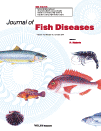Effects of phosphate an phytase supplmenetation on phytate degradation in rainbow trout (Oncorhynchus mykiss W.) and Atlantil salmon (Salmo salar L.)

Abstract
The objectives of the present study were to investigate the single and interactive effects of mineral phosphorus (P) (monoammonium phosphate; MAP; 1 g P/kg DM of diet) and Aspergillus oryzae 6-phytase (2800 FTU/kg DM diet) supplements on the disappearance of phytic acid (InsP6) and its lower inositol phosphate isomers (InsPs) and related P digestibility effects in Atlantic salmon (S. salar) and rainbow trout (O. mykiss).
For each species, one experiment was conducted applying species-specific conditions but using the same diets in both experiments. Faeces were obtained by stripping the fish. The faecal InsP6 disappearance was similar in Atlantic salmon (8.6%) and rainbow trout (8.1%) when diets did not contain the MAP or phytasesupplement. Phytase supplementation significantly increased InsP6 disappearance in both species, but to a larger extent in rainbow trout.
The hydrolysis of lower inositol phosphate isomers progressed to a greater extent in rainbow trout. Supplementation of MAP had no significant effect on InsP6 disappearance in rainbow trout but slightly decreased InsP6 disappearance in Atlantic salmon. No significant interactive effect of the supplements on InsP6 disappearance was detected in both experiments. The analysis of InsPs in the faeces of the two species suggested that the degradation pathway of InsP6 differed between the two species. In both species, each supplement increased the amount of digested P. This effect was additive in rainbow trout but not in Atlantic salmon. In Atlantic salmon, the MAP supplementation decreased the efficacy of phytase by reducing the amount of digested InsP-P to negligible amounts. However, no significant interactive effect of MAP and phytase supplementation on P digestibility, digested P, and digested InsP-P was detected in either species.
The present study provided insight into details of InsP6 degradation in the digestive tract and revealed similarities and differences between the two fish species. The effects of phytase in Atlantic salmon when using low-P diets may not be the same for commercial diets that contain more inorganic P.
